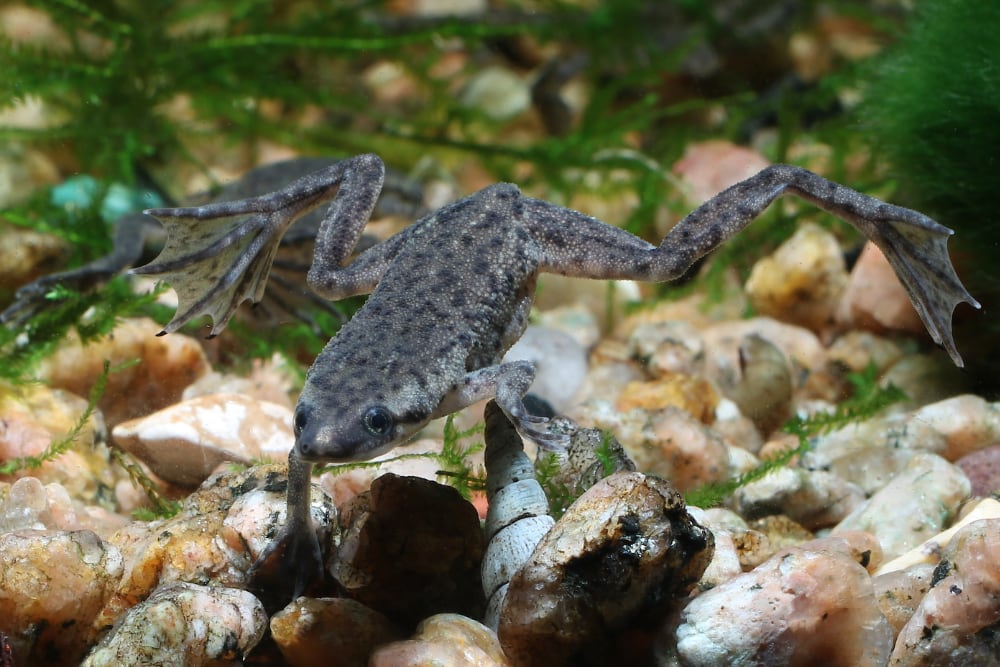Signs of a Happy African Dwarf Frog: A Comprehensive Guide
Introduction: Keeping an African dwarf frog in captivity can be a rewarding experience, especially when you see your aquatic companion thriving and happy. In this guide, we’ll explore the key indicators that your African dwarf frog is content and in good health.
1. Swimming Actively: African dwarf frogs are known for their constant activity in the water. Observing your frog swimming actively is a clear sign of happiness. These fully aquatic creatures seldom stay idle and exhibit playful behaviors, such as burbling, which adds to the joy of owning them.
2. Surface Breathing and Jumping: Healthy and happy African dwarf frogs will consistently come up to the surface to breathe, showcasing their robust respiratory behavior. Additionally, their occasional attempts to jump out of the water, especially during feeding, reflect a content and lively demeanor.
3. Bottom Dwellers’ Behavior: While these frogs are active swimmers, they often spend a significant amount of time at the bottom of the tank. This behavior is perfectly normal and indicates a happy dwarf frog. However, floating at the top may be a sign of distress or illness.
4. Reaction to Handling: A content African dwarf frog will instinctively swim away when approached or handled. This behavior is a sign of well-being. Conversely, a stressed or unwell frog may not exhibit the same swift reaction.
5. Clear Eyes and Smooth Skin: Examining your frog’s eyes and skin is crucial. Clear eyes and smooth, unharmed skin are indicators of a happy and healthy African dwarf frog. Any discoloration or fuzzy patches may signal an underlying issue.
6. Quick Food Consumption: A voracious appetite is a positive sign of a happy African dwarf frog. These frogs typically finish their food quickly. If your frog shows a lack of interest in eating or takes longer to consume its meals, it could be a sign of unhappiness or illness.
7. Shedding Skin in One Piece: Regular shedding is a natural part of an African dwarf frog’s growth. If your frog sheds its skin in one piece, it is a good indication of overall well-being. Multiple pieces of shed skin may suggest underlying health issues.

8. Interaction with Tank Mates and Owners: African dwarf frogs are social creatures. Interacting positively with tank mates and responding to the owner’s gestures are signs of a happy frog. Lack of interaction or avoidance behaviors may indicate stress.
9. Hiding Behavior: Frequent hiding during the day is a normal and instinctual behavior for African dwarf frogs. If your frog retreats to hiding spots, it suggests a healthy adaptation to its environment.
10. Humming or Buzzing: The buzzing sound produced by your African dwarf frog is a notable sign of happiness. This behavior, often mistaken for singing, is more pronounced during mating periods, reflecting an active and content state.
Ways to Ensure Happiness:
To maintain a happy and healthy African dwarf frog, consider the following:
- Provide Adequate Space: Ensure your frog has a spacious environment.
- Use Air Bubbles: Install an air stone and pump for added enrichment.
- Ensure Proper Lighting: Establish a lighting system to mimic day and night cycles.
- Maintain Warmth: Use a tank heater to keep the environment warm.
- Offer Weekly Treats: Treat your frog with brine shrimp, bloodworms, or other favorites.
- Avoid Strong Water Currents: Ensure the tank’s filtration system doesn’t create stress-inducing water currents.
- Include Decor Items: Decorate the tank with items that provide hiding spots and entertainment.
Conclusion: By understanding and observing these signs, along with providing proper care and attention, you can ensure a happy and thriving life for your African dwarf frog. Remember, a joyful frog is a healthy frog.
African Dwarf Frog

The Origins of the African Dwarf Frog
African dwarf frogs were first discovered in rivers, streams, puddles, and shallow ponds in various regions throughout Central Africa in the late 19th century. They are members of the Hymenochirus genus of aquatic frog species and are easily confused in appearance with the other frog species in their group, the African clawed frogs. While these fully aquatic amphibians both belong to the Pipidae family and may appear to look similar, they do have different physical and behavioral traits, which are important for beginner African dwarf frog owners to identify prior to adoption.
Identifying Male and Female African Dwarf Frogs
There are several distinct features that make it easy to identify male and female African dwarf frogs. Male African dwarf frogs are typically smaller in size as they mature, develop small glands behind their front legs called post-axillary subdermal glands, have a small tail, and “buzz” quite loud when they are excited or trying to attract their mates. Females are typically larger in size with pear-shape bodies as they mature, develop longer tails, and aren’t known to buzz. When the males buzz, it is typically at night when they are most active. African dwarf frogs are nocturnal. In the wild, they hunt for food at night and rest during the day.
Choosing The Right Aquarium For Your African Dwarf Frog
The size of your aquarium will depend on how many African dwarf frogs you would like to raise. Since they are very small frogs and only grow to a maximum of 3 inches, a 2.5-gallon aquarium is recommended for housing one African dwarf frog. A 5-gallon aquarium is recommended for housing two, and a 10- to 20-gallon aquarium is recommended for more than two. Although African dwarf frogs are fully aquatic, they have lungs and need to rise to the surface of the water frequently for air. Their webbed feet make it difficult for them to swim in deep water. Avoid placing them in aquariums that are more than 12 inches deep. If their aquarium is too deep, they will struggle to reach the top for air and drown.
Setting Up Your African Dwarf Frog Aquarium
As with all herps, maintaining a proper living environment for your African dwarf frog is key to preventing stress, disease and a shortened life. The following tips for properly setting up and maintaining their living space are highly recommended:
- Maintain water temperatures between 72-78 degrees Fahrenheit. The water should be similar temperatures to the African dwarf frog’s native habitat in Africa. A submersible heater and a digital thermometer are essential for maintaining these temperatures.
- Maintain PH levels between 6.5 – 7.8. These levels can be monitored regularly using PH testing kits.
- Use large aquarium gravel to cover the bottom of the tank. Gravel comes in different sizes and colors. If the grains are too small, the frogs can accidentally consume it and have a difficult time digesting it. This could lead to impaction and can be fatal. Sand is another option for substrate. It is recommended that a substrate be used in any aquarium, but some African dwarf frog keepers opt out of using substrate in fear of their frogs consuming it. It is a personal choice, but substrates make it easier to secure live and artificial plant decorations in the aquarium.
- Always secure the aquarium with a lid. African dwarf frogs spend their whole lives underwater and are not capable of surviving on dry land for more than 15-20 minutes. If they escape, their skin will dry out and they will not survive. Be mindful that African dwarf frogs require oxygen at the water’s surface, so it is best to use a screen lid. If you use a solid lid, make sure it remains open a crack so that your frog can access air to breathe.
- Avoid the use of large filters. African dwarf frogs are very sensitive to noise and they don’t have ears. They use the lateral lines on their bodies to sense vibrations. Large filters can induce stress and sickness. These frogs also prefer motionless water, so make sure the filters don’t cause strong water currents in the aquarium. An under-gravel filter is recommended. Always check with an aquarium specialist online or in store if you are uncertain. If the aquarium is small and maintained regularly, African dwarf frogs can do just fine without one.
- Provide 10-12 hours of aquarium lighting daily. African dwarf frogs are nocturnal and require a regular day and night cycle. They don’t need UVB lighting like many reptile and amphibian species do. A basic LED hood light is sufficient. Avoid placing the aquarium in a room without windows. Rooms with natural sunlight will work just fine too.
- Use filtered water in the aquarium. Raw water contains harmful chemicals such as chloramine and fluoride that can be toxic to all aquatic species. If you use tap water, be sure to treat it with anti-bacterial supplements and water conditioners prior to placing the African dwarf frog back in. Avoid the use of soap to clean the aquariums. Soap can leave residue in the aquarium and make the frogs sick.
- Perform water changes bi-weekly. It is best to change at least 10-25% of the water every 2-4 weeks. If a filter is not being used, then it is best to change the water at least once a week. Frogs shed and can be messy eaters. Avoid performing full water changes. This could cause stress and fatally shock African dwarf frogs.
- Avoid aquarium décor that is sharp and toxic. African dwarf frogs are hunted in the wild and require places where they can hide out in such as caves or logs. African dwarf frogs do well with artificial or real plants, but plants with sharp edges can tear at the frog’s skin. Some wood décor can contain harmful toxins that increase PH levels in the water. Always check with an aquatic specialist online or in store if you’re uncertain about which decorations to use.
Foods To Feed Your African Dwarf Frog
An African dwarf frog’s diet should contain a high protein and well-balanced selection of food consisting of specialized aquatic frog sinking pellets, freeze dried bloodworms, frozen brine shrimp, daphnia, and live blackworms. African dwarf frogs have poor vision and rely on their sense of smell and touch to eat. They have no tongues or teeth to help them chew, so the food that they consume should be cut up in small pieces and fed to them in small portions.
Source: https://reptilesmagazine.com/caring-for-the-african-dwarf-frog/
